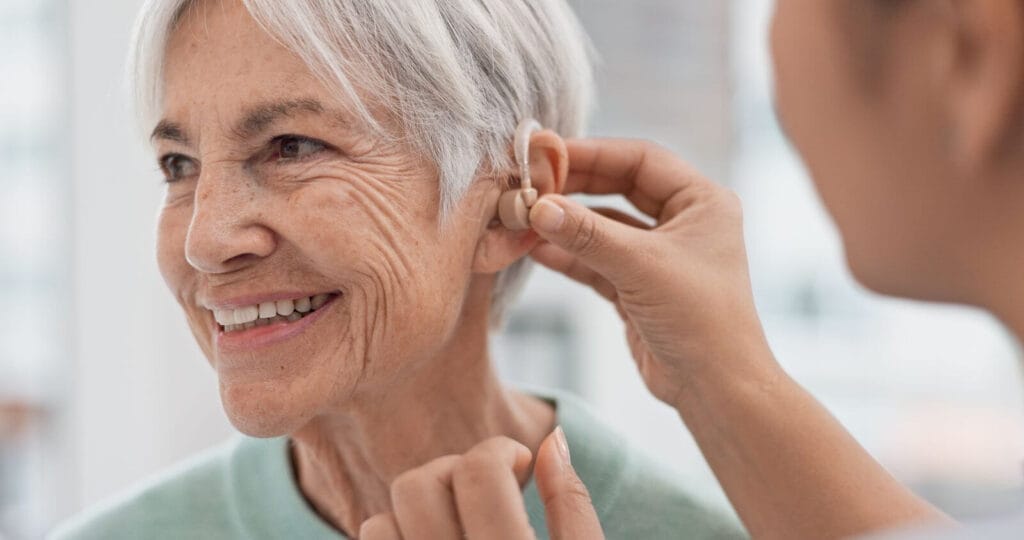
Hearing loss is a common issue among older adults that can lead to problems with health and emotional well-being. Hearing aids are essential tools that help people who experience hearing loss. They typically sit in or behind the ear and amplify sound and improve clarity, helping individuals better hear and understand what is happening around them and keeping them safe and engaged. Hearing aids are FDA-regulated medical devices that come in different forms and work using various mechanisms, allowing people to tailor their devices to their needs. In this article, we will go over the basics of hearing aids and how they work to help people with hearing loss stay connected.
How hearing aids work
Damage to the ear causes changes in how the parts of the ear work and transmit signals to the auditory nerve. Most hearing loss has two components, attenuation and distortion, meaning sounds are both quiet and distorted, making them difficult to hear and understand. For this reason, hearing aids do more than simply amplify sounds; they also make speech clearer.
People with hearing loss also often have more difficulty understanding speech in noisy places like restaurants. Hearing aids typically can help reduce background noise, making it easier to communicate and understand in noisy atmospheres. Some hearing aid technologies, such as directional microphones and digital noise reduction processing, make it easier for a person with hearing loss to hear in noisy environments. For each new generation of hearing aids, engineers work to further optimize the signal processing for these difficult situations.
Hearing aid fittings help the user achieve the right balance between volume level and auditory comprehension. Sometimes, though, the user may have to compromise comfort for optimal speech understanding, especially with more severe hearing loss.
Find the Best Hearing Aids For You!
Benefits and limitations
Wearing hearing aids has many benefits because these devices can mitigate many of the challenges associated with hearing loss. For example, people with hearing loss can find it difficult to communicate and connect with loved ones. They may even lose employment due to difficulty understanding the people and situations around them. These circumstances can lead the individual to become more isolated, which can, in turn, contribute to mental wellness issues. Hearing loss is also tied to a greater risk of falling, experiencing accidents, and even receiving a dementia diagnosis. Wearing hearing aids can reduce social isolation, dementia risk, and unemployment. Greater awareness of sounds in the environment also improves safety.
Despite advances in hearing aid technology, noisy environments still pose challenges for people with hearing loss. People with hearing loss may still need to learn strategies to improve communication, such as looking for seating in a quieter spot in a restaurant. People with severe or profound hearing loss may opt for a cochlear implant because these surgically implanted hearing devices can bypass a damaged portion of the ear and reach the auditory nerve to help a person hear when they have profound hearing loss.
Different types of hearing aids
Hearing aids are available both over the counter and with a prescription. Over-the-counter hearing aids, intended for adults with mild to moderate hearing loss, do not require a prescription or a visit to a medical professional. Prescription hearing aids are for people of all ages (including children) with any degree of hearing loss. They are prescribed by licensed hearing care professionals such as audiologists and, in some cases, hearing aid dispensers, subject to state licensing rules.
Most hearing aids are air-conduction devices, meaning they deliver sound to the ear canal. The sound then travels down the canal, past the eardrum, through the middle ear, and to the cochlea in the inner ear. The cochlea picks up the sound and delivers it to the auditory nerve.
In bone-conduction devices, a vibrator on the skull simulates the cochlea. With bone-conduction hearing aids, the sound is transmitted to the inner ear directly without first traveling down the ear canal. Bone-conduction devices can be surgical or nonsurgical.
Consumers can also choose from different styles, including:
- Receiver in the canal (RIC): RIC hearing aids house the microphone and computer chips in a small case behind the ear. The final processed sound is transmitted via a wire to a small speaker in the ear canal.
- Behind the ear (BTE): BTE hearing aids house the microphone, computer chips, and speaker in a case behind the ear. The sound from the speaker is carried in a plastic tube that goes into the ear. A custom mold holds the plastic tube in place in the ear.
- In the ear (ITE): ITE hearing aids hold the microphone and all electronics in a custom-made plastic shell in the ear. The shell protrudes into the bowl-like portion of the outer ear.
- Completely in the canal (CIC): These are similar to but much smaller and less visible than ITE aids. They do not protrude as much into the outer ear.
In general, styles that place the main electronics behind the ear (see RIC and BTE above) offer more flexibility for severe hearing loss and provide more room for technology such as Bluetooth connectivity.
Analog vs. digital hearing aids
All modern prescription hearing aids operate on digital, not analog, processing. Analog hearing aids amplify all sounds equally in a continuous form, much like how a loudspeaker works. They directly amplify sounds without correcting for background noise or other factors.
In digital hearing aids, the sound waves are converted into digital information, which can then be manipulated to address the user’s specific needs. Hearing aid microphones pick up sound and convert it to an electrical signal. Then, analog-to-digital converters sample the electrical signal thousands of times per second and record numbers that represent the intensity of the signal. The computer chips then manipulate these numbers.
In the past, analog hearing aids were prevalent. The first fully digital devices for the commercial market were introduced in 1996 by the manufacturers Oticon and Widex, and since about 2000, most are digital.
Where to find more information
The most credible, unbiased sources of information about hearing aids on the internet come from professional audiology associations. Additionally, the Hearing Loss Association of America, a consumer advocacy group, and federal government websites offer valuable information. Hearing aid manufacturers’ websites focus on selling a brand’s products and most likely do not offer unbiased opinions.
Some websites to begin your research include:
- American Academy of Audiology.
- American Speech-Language-Hearing Association.
- Hearing Loss Association of America.
- National Institute on Deafness and Other Communication Disorders.
If you’re ready to consult with a hearing care professional about the best options for you, consider making an appointment at a private practice that bills you or your insurance for the cost of your hearing test. Places that offer “free” hearing tests typically hope to recoup the cost of their time by selling you a hearing aid. Several of the “free” hearing test chains are owned by hearing aid manufacturers that promote one brand over others. You’re more likely to get a thorough evaluation in an independent private practice.








